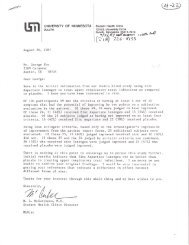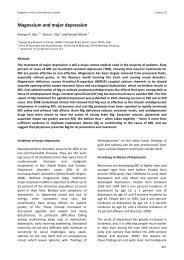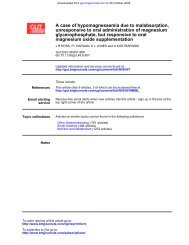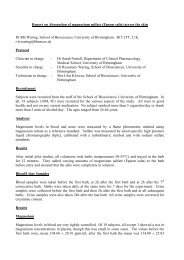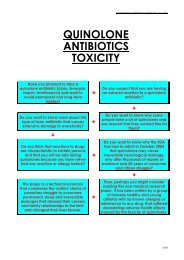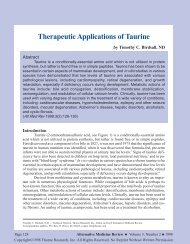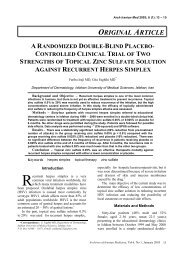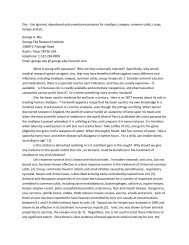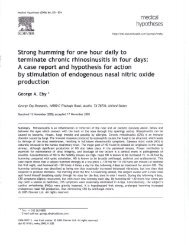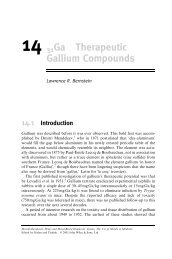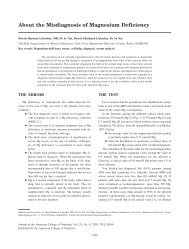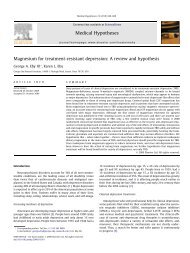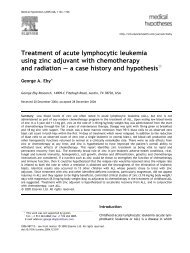The multifaceted and widespread pathology of magnesium deficiency
The multifaceted and widespread pathology of magnesium deficiency
The multifaceted and widespread pathology of magnesium deficiency
Create successful ePaper yourself
Turn your PDF publications into a flip-book with our unique Google optimized e-Paper software.
170 Johnson<br />
Al may be ingested in well water or in the form <strong>of</strong> Al<br />
laxatives. While Cd is <strong>of</strong>ten derived from cigarette smoking<br />
<strong>and</strong> Pb from occupational hazards. Fe accumulates<br />
with age in men <strong>and</strong> postmenopausal women.<br />
CORRECTING A MG DEFICIENCY<br />
In order to correct a moderate Mg <strong>deficiency</strong>, a person<br />
with a low Mg diet <strong>and</strong> limited exposure to sunlight,<br />
who ingests 2 cups <strong>of</strong> c<strong>of</strong>fee <strong>and</strong> 2 beers per day, may<br />
require 250 mg Mg, 100 micrograms Se, 400 IU vitamin<br />
E, 25 mg vitamin B6, 6 glasses <strong>of</strong> water <strong>and</strong> reducing the<br />
saturated fat in the diet. On the other h<strong>and</strong>, a person<br />
with plenty <strong>of</strong> exposure to sunlight all year around <strong>and</strong><br />
with a diet rich in B6 <strong>and</strong> Mg (legumes, nuts, vegetables,<br />
fruits), <strong>and</strong> low in saturated fats, <strong>and</strong> 1 cup <strong>of</strong> c<strong>of</strong>fee or<br />
beer per day, <strong>and</strong> taking plenty <strong>of</strong> water, may need only<br />
50 mg Mg per day.<br />
However, since Mg <strong>and</strong> vitamins D <strong>and</strong> B6 have low<br />
toxicity, providing 100 mg Mg, 100 micrograms Se, 400<br />
IU vitamin D <strong>and</strong> 25 mg vitamin B6 a day in the winter to<br />
all the people living beyond 35˚ <strong>of</strong> latitude seems justified.<br />
On the other h<strong>and</strong>, when there is a severe Mg <strong>deficiency</strong>,<br />
the lack <strong>of</strong> the low levels <strong>of</strong> Mg needed to cause<br />
the release <strong>of</strong> PTH, requires that the parathyroid gl<strong>and</strong> be<br />
primed with a small parenteral dose <strong>of</strong> Mg, so that PTH<br />
be released <strong>and</strong> Mg levels may begin to recover from Mg<br />
in the diet.<br />
Since the liver is involved in vitamin D synthesis <strong>and</strong><br />
storage, vitamin D <strong>deficiency</strong> <strong>and</strong> the deficiencies that<br />
derive from it (Mg, Ca, K <strong>and</strong> P), must be addressed in<br />
patients suffering from cirrhosis, hemochromatosis,<br />
Wilson’s disease <strong>and</strong> other major liver diseases.<br />
Finally, since Pb <strong>and</strong> Cd antagonize Mg, patients with<br />
high levels <strong>of</strong> these elements would benefit from chelation<br />
therapy with succimer, which only removes these<br />
toxic metals, sparing Cu, Zn <strong>and</strong> other essential metals.<br />
CONCLUSIONS<br />
Even though Mg is readily available in food, the large<br />
number <strong>of</strong> favorable conditions required for its absorption<br />
<strong>and</strong> retention <strong>of</strong>ten result in a <strong>deficiency</strong>, which can<br />
manifest itself in a myriad symptoms <strong>and</strong> signs, encompassing<br />
an extremely wide range <strong>of</strong> pathologies.<br />
Unfortunately, evaluation <strong>of</strong> the Mg status is complicated<br />
by the fact that most <strong>of</strong> the Mg is stored in tissues, so<br />
that serum values are not truly representative. For example,<br />
a patient with an apparently healthy serum Mg <strong>of</strong><br />
2 mg/dl may have low intracellular Mg stores, because<br />
cellular Mg uptake may be impaired.<br />
Furthermore, the same large number <strong>of</strong> conditions<br />
required for the maintenance <strong>of</strong> proper Mg levels greatly<br />
complicates the evaluation <strong>of</strong> the effect <strong>of</strong> Mg during<br />
clinical trials. <strong>The</strong>refore, it is essential that researchers<br />
underst<strong>and</strong> all these conditions very well.<br />
Finally, since Mg is very inexpensive <strong>and</strong> has an<br />
extremely low toxicity, <strong>and</strong> since vitamin D <strong>and</strong> B6 are<br />
also very inexpensive (in most cases, vitamin D can be<br />
increased by simple exposure to sun light) it is deplorable<br />
that Mg <strong>deficiency</strong> should still be the cause <strong>of</strong> so much<br />
suffering <strong>and</strong> expense, even in the most advanced societies.<br />
REFERENCES<br />
1. Mortensen L., Hyldstrup L., Charles P. Effect <strong>of</strong> vitamin D<br />
treatment in hypoparathyroid patients: a study on calcium,<br />
phosphate <strong>and</strong> Mg homeostasis. Eur J Endocrinol 1997; 136 (1):<br />
52–60.<br />
2. Toroman<strong>of</strong>f A., Ammann P., Moseskilde L., Thomsen J. S., Riond<br />
J. L. Parathyroid hormone increases bone formation <strong>and</strong><br />
improves mineral balance in vitamin D-deficient female rats.<br />
Endocrinology 1997; 138 (6): 2449–2457.<br />
3. Price S. A., Wilson L. M. Pathophysiology. 5 th edition. Mosby-Year<br />
Book, Inc, 283, 1997.<br />
4. Price S. A., Wilson L. M. Pathophysiology. 5 th edition. Mosby-Year<br />
Book, Inc, 274, 1997.<br />
5. Chareonpong Kawamoto N., Yasumoto K. Selenium <strong>deficiency</strong><br />
as a cause <strong>of</strong> overload <strong>of</strong> Fe <strong>and</strong> unbalanced distribution <strong>of</strong><br />
other mineral. Biosci Biotechnol Biochem 1995; 59 (2): 302–306.<br />
6. Koltas I. S., Ozcan K., Tamer L., Aksungur P. Serum copper, zinc<br />
<strong>and</strong> <strong>magnesium</strong> in children with enterobiosis. J Trace Elem Med<br />
Biol 1997; 11 (1): 49–52.<br />
7. Khayyal M. T., Khayyal M. A., Sharaf H. M., el Sherbeeny M.,<br />
Okpanyi S. N., Schnaider W. Effect <strong>of</strong> <strong>magnesium</strong> pyridoxal 5phosphate<br />
glutamate on vascular reactivity in experimental<br />
hypercholesterolemia. Drugs Exp Clin Res 1998; 24 (1): 29–40.<br />
8. Liao F., Folsom A. R., Brancati F. L. Is low <strong>magnesium</strong><br />
concentration a risk factor for coronary heart disease? <strong>The</strong><br />
atherosclerosis risk in communities (ARIC) study. Am Heart J<br />
1998; 136 (3): 480–490.<br />
9. Allegra A., Corica F., lentile R. et al. Plasma (total <strong>and</strong> ionized),<br />
erythocyte <strong>and</strong> platelet <strong>magnesium</strong> levels in renal transplant<br />
recipients during cyclosporine <strong>and</strong>/or azathioprine treatment.<br />
Magnes Res 1998; Mar, 11 (1): 11–18.<br />
10. Dyckner T., Ek B., Byhlin H., Wester P. O. Aggravation <strong>of</strong><br />
thiamine <strong>deficiency</strong> by <strong>magnesium</strong> depletion. Acta Med Sc<strong>and</strong><br />
1985; 218 (1): 129–131.<br />
11. Simon N. Infantile autism <strong>and</strong> Wernicke’s encephalopathy. Med<br />
Hypotheses 1990; Jul 32 (3): 169–172.<br />
12. Z<strong>of</strong>kova I., Kanceva R. L. New drugs with positive effects on<br />
bones. Cas Lek Cesk 1997; Jul, 136 (15): 459–463.<br />
13. Mauskop A., Altura B. M. Role <strong>of</strong> <strong>magnesium</strong> in the<br />
pathogenesis <strong>and</strong> treatment <strong>of</strong> headaches. Chem Neurosci 1998;<br />
5 (1): 24–27.<br />
14. Itokawa Y. Tissue minerals <strong>of</strong> <strong>magnesium</strong> deficient rats with<br />
thiamine <strong>deficiency</strong> <strong>and</strong> excess. Magnesium 1987; 6 (1): 48–54.<br />
15. Wecker L., Miller S. B., Cochran S. R., Dugger D. L., Johnson W.<br />
D. Trace element concentration in hair from autistic children.<br />
J Ment Defic Res 1985; 291(1): 15–22.<br />
16. Eppright T. D., Sanfancon J. A., Horwitz E. A. Attention deficit<br />
disorder, infantile autism <strong>and</strong> elevated lead: A possible<br />
relationship. Mo Med 1996; 93 (3): 136–138.<br />
17. Accordo P., Whitman B., Caul J., Rolfe U. Autism <strong>and</strong> plumbism:<br />
A possible association. Clin Pediatr (Phila) 1988; 27 (1): 41–44.<br />
Medical Hypotheses (2001) 56(2), 163–170 © 2001 Harcourt Publishers Ltd



